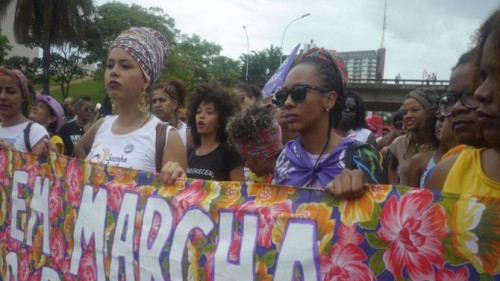Fighting Poverty, Plagued by Violence: Why 10,000 Black Women in Brazil Marched for Their Rights
Share
Explore Our Galleries
Breaking News!
Today's news and culture by Black and other reporters in the Black and mainstream media.
Ways to Support ABHM?
Black women from all over Brazil, of different backgrounds, education and socioeconomic status, came together to protest widespread inequality.
BY KIRATIANA FREELON, The Root
They were lawyers, feminists, Christians, transgender women, domestic workers, militants, favela dwellers, politicians, students and many more. Despite their differences in beliefs, education and income, on Wednesday they came together behind the one thing they had in common: being a black woman in Brazil. On that day, more than 10,000 black women from all over the country gathered in…Brasilia, for the first national black women’s march—Marcha das Mulheres Negras. The march’s tagline was, “Against racism and violence and for the well-being.”

More than 10,000 women from Brazil march for their rights on November 18, 2015. (Photo credit: Kiratiana Freelon)
“This is the first time black women coming from all parts of the country came to Brasilia with the same message,” said Ivana Braga…“It doesn’t matter if a black woman is in Congress, is a civil servant, in academia or is a domestic worker; their skin color will continue to play a part in how their rights are denied.”
Braga, 38, marched alongside her 63-year-old mother, Maria dos Rosana Moraes. “It was important for me to bring my mother because she has been a domestic servant since she was 13 years old,” said Braga, who promotes women’s rights in Maranhão and is a Fulbright scholar. “She was denied rights her entire life.
“This isn’t just my fight or her fight. It comes from generations of women who were denied their rights,” Braga added.
Statistics show that black Brazilian women suffer some of the highest rates of violence and poverty in Brazil. A study…found that violence against black women in Brazil increased 54 percent between 2003 and 2013. In 2013…more than 2,800 black women died from violence. Violence against white women in the same 10-year period decreased 18 percent.
Black women are also losing their…family members to violence. Of the 60,000 homicides in Brazil each year, more 40,000 of the victims are blacks. From 2002 until 2012, the number of black victims of homicide increased from 29,656 to 41,127. Black women even suffer in the workplace…On average, they earn $364 per month, which is about 44 percent of the average pay for white men, 75 percent of the pay for black men and 60 percent of the pay for white women.
National organizers planned the march for almost two years. It had been originally scheduled for…May 13, the day millions of slaves were freed in Brazil in 1888. But organizers changed the date to Nov. 18 to coincide with the National Week of Black Consciousness in Brazil. During this week, Afro-Brazilians celebrate the life of Zumbi dos Palmares, the leader of a community of escaped slaves in Brazil that existed more than 300 years ago. Nov. 20 is the Day of Black Consciousness in Brazil…

Members of the Sisterhood of Our Lady of Good Death cheered on black women marching for their rights. (Photo credit: Kiratiana Freelon)
Volunteer organizers in…Brazil worked closely with local communities for more than a year to promote the event and to raise money to bring thousands of women to Brasilia. Organizers in Niteroi sold feijoada dinners and T-shirts. Rio de Janeiro organizers even held a local premarch…July 26 to celebrate the Day of the Black Woman in Latin America and the Caribbean.
As a regional organizer, Braga spent months visiting local communities of black women to talk to them about racism, violence and socioeconomic issues…Five busloads of women departed from São Luis on the Monday before the march and arrived in Brasilia Wednesday in the early-morning hours. The marchers slept in a local stadium, and by 11 a.m. the same day, they started to march.
Priestesses of Candomblé, an Afro-Brazilian religion, led the marchers…toward Brazil’s congressional building. Along the way, the women…sang, chanted and danced to inspirational music.
“I cried when I was marching,” said Jamille Sepol, vice president of the Justiça Negra collective. “But I was crying because I was happy to experience this moment for black people, black women, the black movement, for black youth and children. We needed this pride, and this day was a day to be proud of…”
Shortly after the march, a group of black women met with the president and Nilma Lino Gomes, Brazil’s minister of women, racial equality and human rights. The goal of the march was to amplify the voice of black women in Brazil, and activists say they have no doubt that they succeeded.









Comments Are Welcome
Note: We moderate submissions in order to create a space for meaningful dialogue, a space where museum visitors – adults and youth –– can exchange informed, thoughtful, and relevant comments that add value to our exhibits.
Racial slurs, personal attacks, obscenity, profanity, and SHOUTING do not meet the above standard. Such comments are posted in the exhibit Hateful Speech. Commercial promotions, impersonations, and incoherent comments likewise fail to meet our goals, so will not be posted. Submissions longer than 120 words will be shortened.
See our full Comments Policy here.